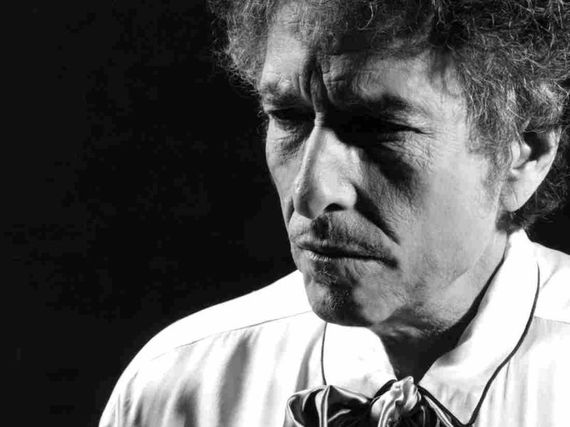
Good God! After all these years and all those albums, Bob Dylan still retains the power to surprise us and reinvent himself with his music.
When Shadows in the Night was announced last year, it sounded like another of Dylan's late-career oddities -- like his Christmas album or his cameo appearance on Pawn Stars.
Surely he couldn't be entirely serious about recording an album of moody pop ballads previously sung with finesse by Frank Sinatra? When you think of Dylan, you think of singer-songwriter. You don't think of "romantic crooner." Yet songs like "I'm a Fool to Want You," "That Lucky Old Sun," "Some Enchanted Evening" and "Stay With Me" (not the Faces' song) demand crooning.
Making the just-released project (on longtime label Columbia) more challenging, with age (he's now 73), Dylan's voice has become more grizzled and harsh. The bluesy country-swing music his band specializes in sometimes seems designed to cover his singing up, at least live in concert. So the first surprise of Shadows in the Night is how good Dylan's voice sounds on these 10 tracks. That's an understatement -- there is beauty in his singing. Gentleness. Soul.
There is also deliberateness to his enunciation and pacing, which frankly may surprise many. And that voice isn't auto-tuned -- he and his band recorded all the songs live in the studio, many with single takes. There were no overdubs.
It sounds as if he is aiming to sing higher than normal, or at least lighter and more smoothly than he has done on anything since Nashville Skyline. Yet, unlike that record, there's nothing affected or artificially stylized about the voice. When he sings the melody, holds his notes or emphasizes phrasing, he just sounds comfortable and relaxed with his choices. But he's thoroughly engaged.
He doesn't mumble his way through or growl ominously. As a result, this album is touching and smitten with the dreamy, longing quality of the source material. But its quietude haunts. It's a bit like watching an old Astaire musical on TCM in the middle of the night. From the guy who sang "Love Sick" and "Not Dark Yet," that's quite a feat.
He isn't perfect at it, obviously. There are times when the pitch wanders and his singing gets a little unsteady. But then, this gives lived-in truth and melancholy reflection to the slower songs, especially those here like "Autumn Leaves" (originally a French song to which Johnny Mercer wrote English lyrics and Sinatra recorded in 1956) and "Full Moon and Empty Arms" (recorded by Sinatra in 1945, the same year written by Buddy Kaye and Ted Mossman) that reflect upon loss or regret.
Too, Dylan is full in on this project -- he produced it. He's convinced that now is the time for his voice turn to these tunes. (He has on special occasion sung a pop standard, such as "I'm in the Mood for Love," or written in that style, before.) And the "shadows" in the album title have meaning. He's going where these songs -- or at least this kind of sophisticatedly wistful, elegantly written adult pop music -- apparently affected him in his youth. He is exploring them as if they were a series of dreams from long ago.
The second big surprise is the instrumental backing. These couldn't be further from the orchestral arrangements Sinatra favored on his greatest albums from the 1950s, In the Wee Small Hours and Frank Sinatra Sings for Only the Lonely.
His band -- bassist Tony Garnier, guitarists Charlie Sexton and Stu Kimball, percussionist George G. Receli -- provide such soft backing it's almost as if they're laying down guide tracks. Really, to use another 1950s musical reference, this sounds like it was recorded in Martin Denny's "Quiet Village" on a very laid-back day.
It's largely left to pedal steel guitarist Donny Herron -- who does great work -- to provide some color and ornamentation to the arrangements. His gentle interplay with Dylan on "I'm a Fool to Want You" (which dates to 1951 and which Sinatra had a hand in composing with Joel Herron and Jack Wolf) coaxes out some of his best singing.
There is also some minimal sweetening from brass instruments, especially on "That Lucky Old Sun," which Dylan makes elegiacally spiritual. Sinatra was one of several artists who recorded it in 1949, the year it was written by Beasley Smith and Haven Gillespie. While clearly a pop song, "Lucky Old Sun" has since been recorded by enough roots artists to be considered part of the Great Americana Songbook. Dylan's version adds to that list.
And this brings up the third big surprise of Shadows in the Night. It isn't really a Sinatra tribute per se (and Dylan isn't particularly marketing it as such). It's not even really Dylan going classic pop. Really, it's closer to a neo-country album, a cross between Willie Nelson's Stardust and Johnny Cash's American Recordings series. (Both men have recorded "That Lucky Old Sun.")
If there's an especially apt contemporary comparison with what Dylan is doing here, it's the way pub-rocker/New Waver Nick Lowe found contentment and meaning in crafting new ballads and mid-tempo songs that evoked but didn't mimic 1950s country-pop songs like Marty Robbins' "The Story of My Life."
Given Dylan's artistic restlessness, as well as the fact the importance of his older material (like The Basement Tapes) is growing, not diminishing, with time, one doubts Shadows in the Night marks a permanent new career track for him. He probably won't be following Rod Stewart into the back pages of the American Songbook.
He doesn't seem ready to give up the songwriting or hard-swinging, muscular roots-of-rock music that are his trademarks just yet. But what he has done here is more than a lark. He really loves what he's singing, and it shows. And he has a lot still to teach us about the joys of music.
(From Blurt, www.blurtonline.com, 2-9-15)
(Photo courtesy Columbia Records)